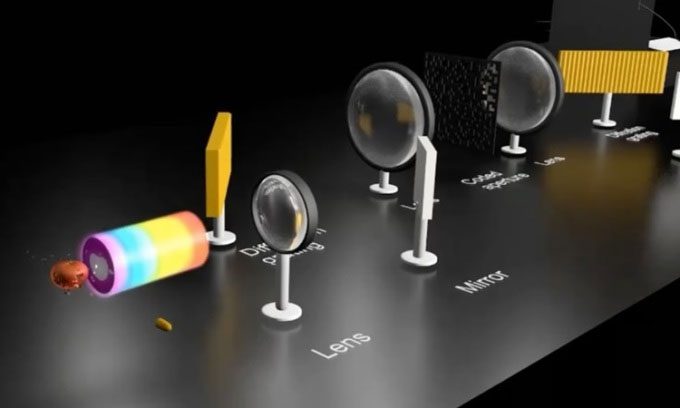Engineers at the INRS Énergie Matériaux telecommunications research center have developed the world’s fastest camera, capable of capturing images at a staggering speed of 156.3 trillion frames per second (fps).
Typically, slow-motion cameras on phones operate at speeds of a few hundred fps, while professional cameras can achieve several thousand fps for smoother effects. However, to observe events occurring at the nanoscale, researchers need capture speeds in the billions or even trillions of fps. The new camera developed by the engineering team at INRS can capture events happening in just a few femtoseconds (one femtosecond is one quadrillionth of a second), according to New Atlas.

Simulation of the world’s fastest camera system SCARF. (Image: INRS).
The research team built upon technology they developed since 2014, known as Compressed Ultrafast Photography (CUP), which can capture images at 100 billion fps. The next phase, called T-CUP (where T stands for “trillion frames per second”), can capture up to 10 trillion fps. In 2020, the researchers achieved 70 trillion fps with a version named Compressed Ultrafast Spectroscopy (CUSP).
Now, they have doubled the speed to 156.3 trillion fps. The new camera system, named the “Real-Time Femto Aperture Scanning Camera” (SCARF), can capture events that happen too quickly for previous technology to observe, such as shock waves traveling through materials or living cells.
SCARF operates by emitting a super-short laser light pulse that passes through the event or object being photographed. If capturing light like a rainbow, the red wavelength will record the event first, followed by orange, yellow, and finally violet. As the event occurs so rapidly, each color arrives in sequence, making the images appear distinct and allowing the laser light pulse to capture the entire change within an extremely short time frame. This light pulse then passes through a series of components that focus, reflect, diffract, and encode it until it reaches the sensor of a Charge-Coupled Device (CCD) camera, which converts it into data that a computer can reconstruct into the final image.
According to the research team, their camera system will enhance fields such as geography, biology, chemistry, materials science, and engineering. They detailed their device in a paper published in the journal Nature Communications.




















































